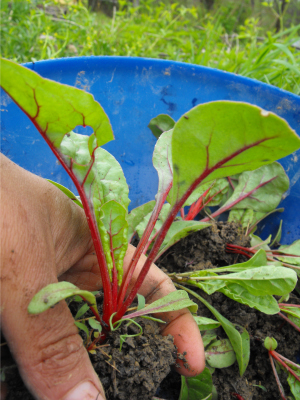
Volunteer swiss chard
 As
I weeded the peas this week, I stumbled across a patch of volunteer
swiss chard growing amid the tendrils. The swiss chard plants
were about three times as big as the seedlings which came up in this
spring's bed, sending me off in mental gyrations.
As
I weeded the peas this week, I stumbled across a patch of volunteer
swiss chard growing amid the tendrils. The swiss chard plants
were about three times as big as the seedlings which came up in this
spring's bed, sending me off in mental gyrations.
I never let my swiss
chard go to seed last year, so these volunteers were clearly sprouting
from last spring's seeds. Why didn't those seeds sprout in
2009? Do some swiss chard seeds always take two years to
germinate (while others clearly germinate right away)?
Why were the volunteer
swiss chard so much bigger than this year's version? Did they
sprout sooner, protected by mulch then warmed in the sunniest part of
the garden? Or do they just like the drainage in the mule garden
better than the back garden?
I have no answers, but I
do suddenly have a bed of swiss chard that will be big enough to eat
next week. I transplanted the volunteers out of the pea bed and
into the many gaps in this year's swiss chard bed, and am anticipating
a copious harvest shortly.
Want more in-depth information? Browse through our books.
Or explore more posts by date or by subject.
About us: Anna Hess and Mark Hamilton spent over a decade living self-sufficiently in the mountains of Virginia before moving north to start over from scratch in the foothills of Ohio. They've experimented with permaculture, no-till gardening, trailersteading, home-based microbusinesses and much more, writing about their adventures in both blogs and books.
Want to be notified when new comments are posted on this page? Click on the RSS button after you add a comment to subscribe to the comment feed, or simply check the box beside "email replies to me" while writing your comment.

Do you think you planted it there a couple of years ago, or is it a true volunteer from some other plants you let go to seed?
After making this post, I was reading that swiss chard has lots of small seeds all connected together in the big "seed" we plant. That's why they come up in clusters, and I suspect the seeds might make their way out of the big cluster at different rates, which might explain why some would germinate the next year.